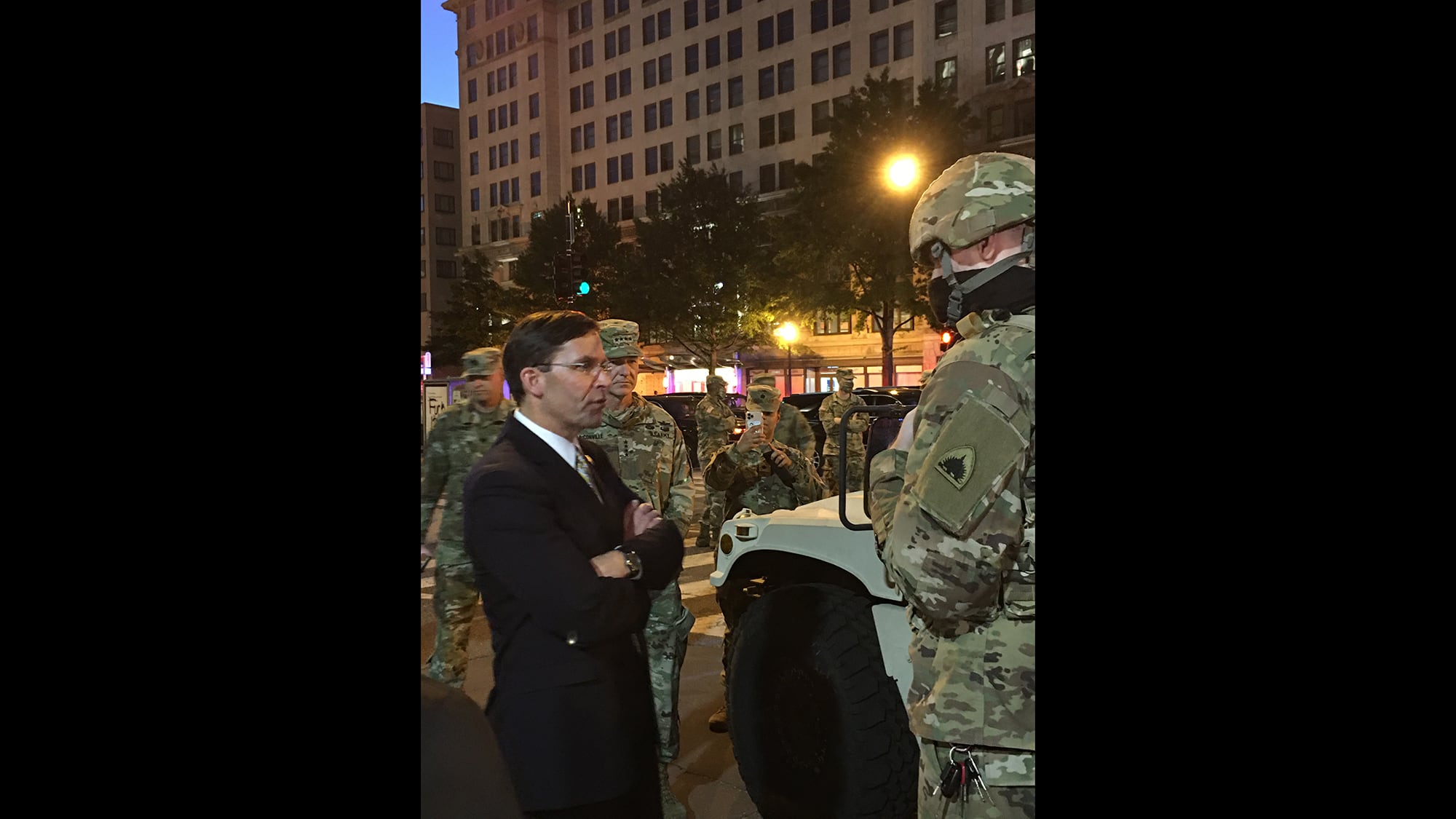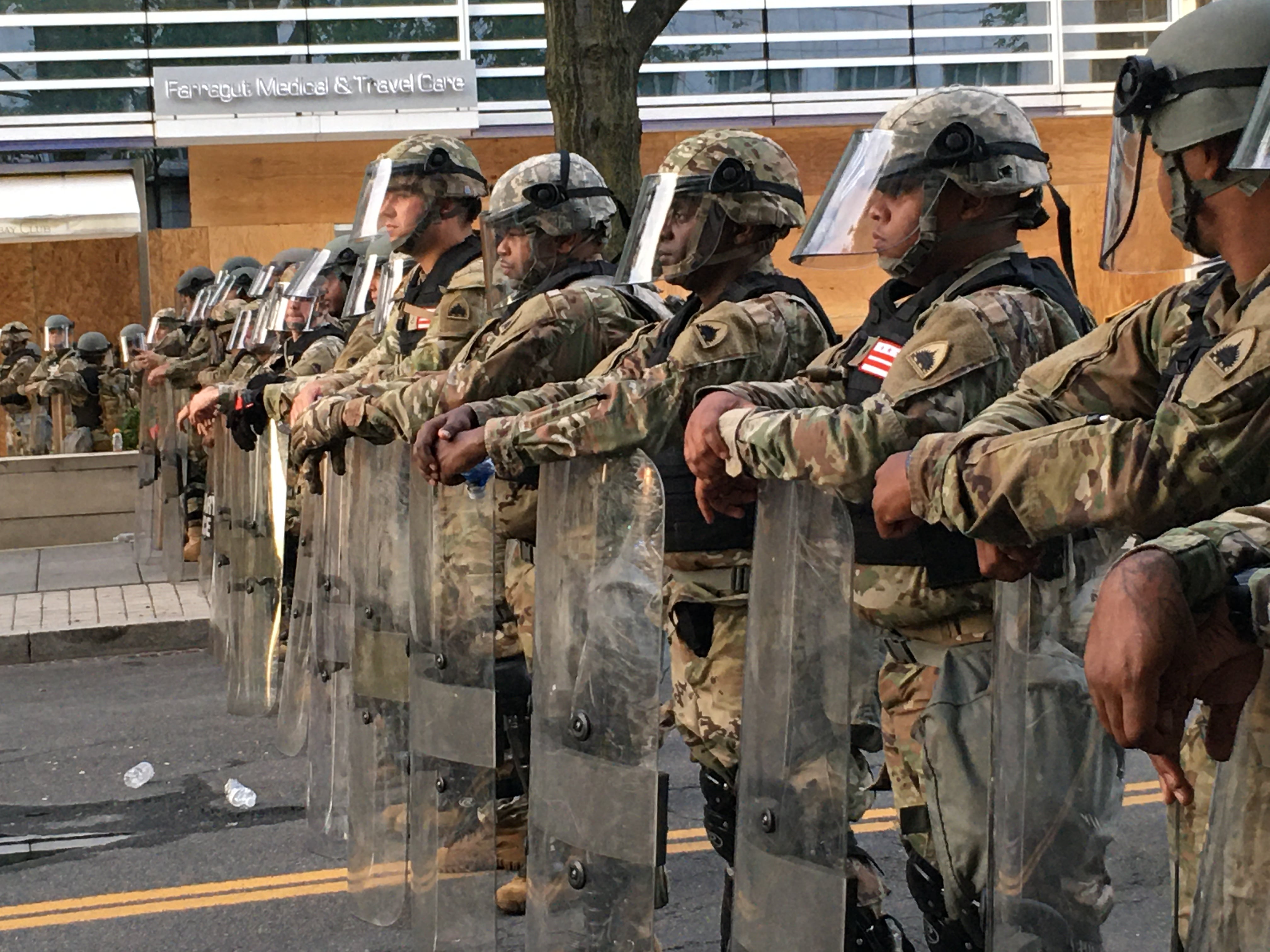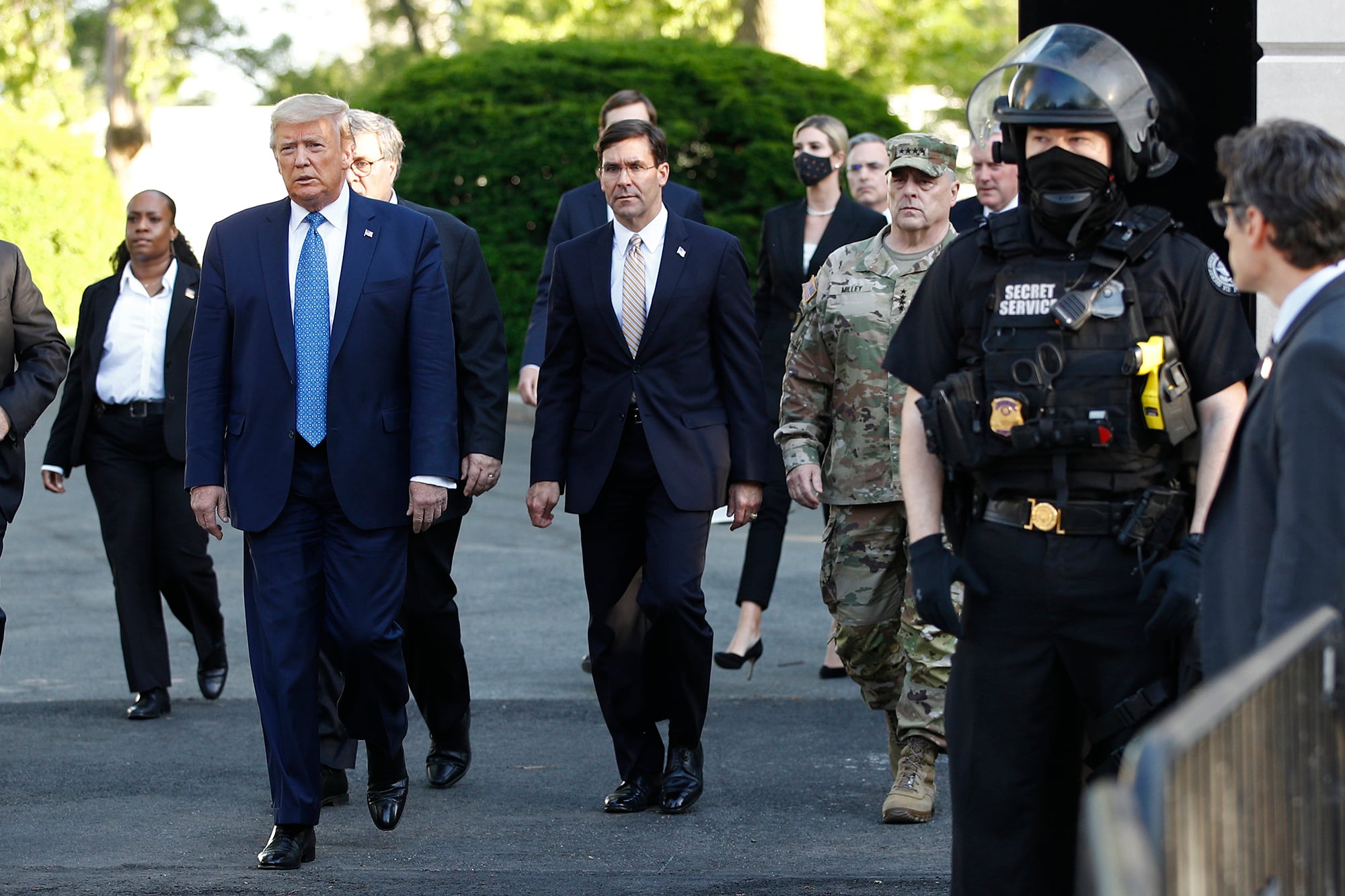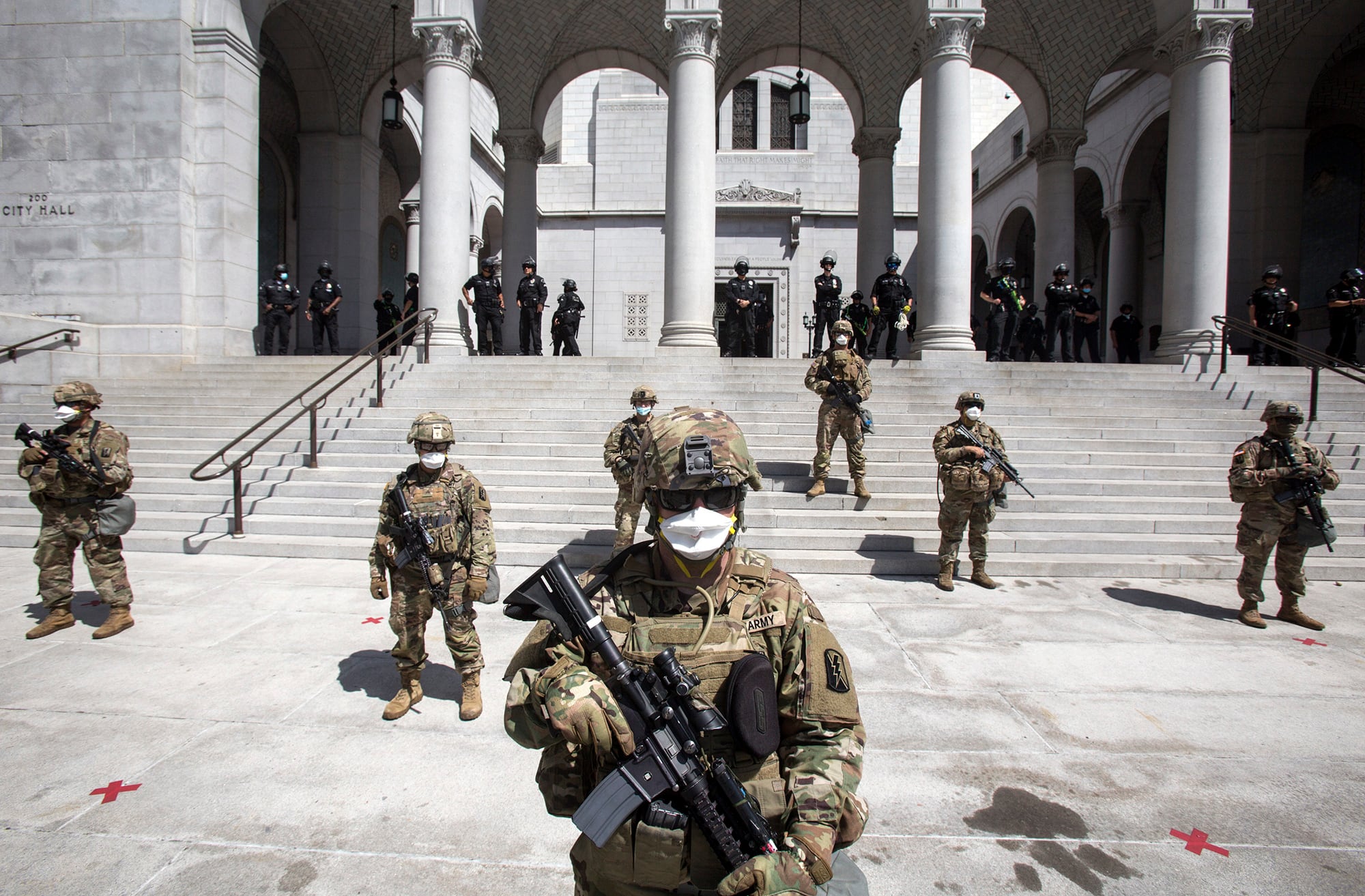With 30,000 National Guardsmen and 1,600 active-duty military police and infantrymen activated across the country to help local civilian authorities push back against protests, some American cities are going to be looking a lot like war zones.
Though defense officials have clarified that any troops will be on site as a show of presence and deterrence, rather than making arrests or deploying weapons against protesters, President Donald Trump’s comments have raised alarms that the White House is politicizing the military by threatening to deploy service members to break up peaceful protests against what prosecutors have alleged was the murder of George Floyd on May 25 by a Minneapolis police officer.
“I am mobilizing all federal and local resources, civilian and military, to protect the rights of law abiding Americans,” Trump said Monday at the White House, citing the Insurrection Act of 1807. “Today I have strongly recommended to every governor to deploy the National Guard in sufficient numbers that we dominate the streets. Mayors and governors must establish an overwhelming presence until the violence is quelled.”
To clarify, Trump had not mobilized federal and local resources nor invoked the Insurrection Act, as police forces and National Guard troops are operating under the orders of their mayors and governors.
The mission is not unlike the one some active duty and National Guard troops have been doing along the U.S.-Mexico border for nearly two years, assisting Customs and Border Patrol with surveillance and security, but not physically detaining anyone.
But the optics of the situation have quickly turned sour for many current service members, who shared their perspectives with Military Times. Of 33 responses from active-duty and reserve component troops reviewed before publication, 30 were opposed to the use of troops to response to protests.
“Using the military to put down protests and supplement the botched efforts of the police to control these protests, particularly through unlawful uses of force, will only further inflame the protests,” a National Guard noncommissioned officer said in an email to Military Times. “This is escalation, not de-escalation. Embroiling the military due to the inaction and failings of the police only serves to conflate the two, and would put both military members and civilians at greater risk. Cracking down with authoritarianism does nothing but further politicize the military and erode the trust the public has in us. There is no winning in this scenario.”
Others were supportive of the plan, viewing it as a community service and part of their oath.
“My answer has always been, 'There is an unmistakable difference between a peaceful protester and a looter; one gathers with the hope of voicing an opinion as protected by the First Amendment while the other is a single-minded entity bent on creating as much chaos as possible and has no connection to the original cause," a Davis-Monthan Air Force Base, Arizona, technical sergeant wrote. “I feel that any community the military has an installation in or near, we should automatically loan our services to, in times of civil unrest, considering we are a part of the community, whether we’d like to think otherwise or not.”
Aside from the message deploying active-duty troops might send, others questioned whether they are necessary.
“I don’t think active-duty military deployments are necessary, especially in DC,” an active-duty Army captain wrote. “I believe the president is deploying the military for political reasons and our reputation will be irreparably damaged by the association.”
Specifically, Defense Secretary Mark Esper authorized an 82nd Airborne Division infantry battalion, the Fort Bragg, North Carolina-based 16th Military Police Brigade’s headquarters and the 91st Military Police Battalion from Fort Drum, New York, to mobilize to the D.C. area.
But on Wednesday morning, he clarified in a Pentagon briefing that he does not believe it’s necessary to employ them in a law enforcement role.
“The option to use active duty forces in a law enforcement role should only be used as a matter of last resort, and only in the most urgent and dire of situations,” he said. “We are not in one of those situations now. I do not support invoking the Insurrection Act.”
RELATED

At the same time, those active-duty forces are awaiting instructions at bases in the D.C. area, Pentagon spokesman Jonathan Hoffman said Tuesday night in a release.
Some service members are wrestling with the idea of doing their jobs, the Army captain said, if these are their orders.
“I oppose these missions, but if they are to happen, I want to be there to make sure they are done the right way, including providing medical care to those who need it and refusing to carry out unlawful or unethical orders,” he said.
The deployments could also affect the public’s view of the National Guard, he added, after all of the good will built up over the COVID-19 pandemic response, which at its height saw more than 45,000 guardsmen running testing sites, delivering food and otherwise acting in a humanitarian capacity.
“This also stands in sharp contrast to the president’s response to the coronavirus pandemic, in which he eschewed the federal government taking an active role and pressed upon those same state governors to do things on their own because it wasn’t the federal government’s job,” an active duty Navy chief wrote.
RELATED

That kind of narrative could also trickle down in other ways, including the Guard’s recruiting efforts.
“She’s worried that all the efforts they’ve made to make the guard diverse and inclusive are being eroded by asking soldiers to stand by cops,” one reader wrote of his wife, a Guard recruiter in the South. “She has recruiting meetings with two people today. Both young black men. She has no idea what to tell them.”
And as far as active-duty troops, some expressed concern about how they would handle themselves in a crowd control scenario.
“I’m totally against using our active duty military personnel for any type of riot control,” an Army staff sergeant wrote. “My main reason is my troops are not trained in crowd control tactics, they are trained to meet and defeat with deadly force any enemy of the U.S. who is attacking us.”
While the mobilized military police will be tasked with providing security, he had questions as to whether their combat training would sway their actions.
“My troops do not have the mind set to just allow someone to throw things at them, or assault them without them striking back using a medium of force that would be considered appropriate for that type of situation, especially if they had live rounds in their M-4s,” he added. “Sorry to say but there would be some dead rioters/insurgents.”

Beyond the movement of troops, some readers commented on the actions of the military’s most senior leaders in the face of the White House’s response to protests and riots.
“It’s one thing to remain silent. It’s a completely different situation when our Pentagon leadership takes part in the politicization of the military,” an active-duty Navy judge advocate lieutenant wrote. “The teargassing of peaceful protesters on live TV and then the photo op by Trump [Monday] was a disgrace. The use of helicopters in Washington, D.C., to intimidate protesters is shameful. Milley’s galavanting around DC is sad. Leaders need to be leaders. Take a stand. Resign. Don’t let the military fall to Trump’s demagoguery.”
Joint Chiefs Chairman Gen. Mark Milley and Esper spoke with D.C. Guardsmen on the street Monday night after visiting the White House under instructions to brief the president on responses to protests nationwide.
Before that could occur, Esper told reporters Wednesday, Trump lead an entourage across Lafayette Square to the burned and boarded-up St. John’s Episcopal Church, where he held up a Bible and gave brief remarks before taking a photo with Esper and other members of the administration.
“What I was not aware of was exactly where we were going when we when we arrived at the church and what the plans were once we got there,” he said.
The scene came after a White House call with governors in which Esper compared U.S. cities to war zones.
“The statement by Secretary of Defense Mark Esper that we should ‘dominate the battlespace’ in American cities was appalling,” a D.C. area-based Army reserve officer wrote. “Farragut Square is not Fallujah. The people peacefully protesting there yesterday were not combatants; they are our fellow Americans.”
Esper clarified those comments Wednesday.
“It is part of our military lexicon that I grew up with. And it’s what we routinely used to describe a bounded area of operations,” he said. “It’s not a phrase focused on people, and certainly not on our fellow Americans, as some have suggested.”
Meghann Myers is the Pentagon bureau chief at Military Times. She covers operations, policy, personnel, leadership and other issues affecting service members.





